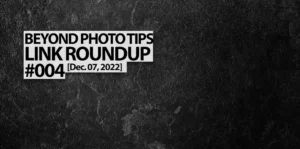One particular post didn’t make it to Beyond Photo Tips when we moved over from Photography Tip. I think it makes sense to re-post it here for the benefit of all those who missed out.
If you’re one of those who’s already read this post, why don’t you join in the fun? Add a tip in the comments; I’m sure we’ll all be able to learn something. Now, here’s the post:
Tips For Shooting Photos on Location
Here are some thoughts that I’ve had while shooting on assignments during the last 2-3 months…
- Make a checklist…
- Check the checklist to make sure you’ve got everything you need (ha ha… Christmas reference).
- Check that you’ve checked the checklist. Remember Santa… He made lists too…
- Always take more equipment than necessary for the shoot.
- Having someone on hand to assist you, and make sure that you have the equipment where you want it, and make sure you don’t leave anything behind is a great thing. Take a friend along if nobody else.
- Stay Professional. It’s why you’ve been hired.
- Stay Funny. It keeps people smiling, and your models pliant.
- Things will go wrong. When they do, breathe deeply, think of the problem, and figure out how to fix or bypass it.
- Keep the Client satisfied, this may mean that you’ll have to take pictures that you wouldn’t take if you were shooting by yourself… Take them anyway…
- Make sure you get the shots you want, even if they’re the ones that the client said no to… they may actually like them!
- Remember to have fun… if you’re not having fun, then you’ve got to change something.
- Plan out the entire photoshoot.
- Make a list of shots that you need to take, and put down the additional ones (the ones you think the client may not like, but think that you need to take anyway)
- Get to the location on time. This refers back to the point about being professional.
- If you can’t be there on time, blame it on the complexity of the job at hand and the tough choices you’ve had to make when it came to equipment selection – just kidding. Don’t do this… It’s not professional.
- Don’t blame the traffic, most likely your client got there the same way that you did.
- If you find yourself shooting for one client while you’re supposed to be at another client’s location shoot, do the same as point 2. But remember to finish off the assignment at hand to the client’s satisfaction first.
- Remember not to take on rush jobs in the first place. They can quickly get messy and will most likely entail more work than you thought they would.
There are a lot more where these came from, but I’d like to hear from you… do you have anything you’d like to add?
Help Us To Continue Creating
Get our email newsletter to stay up-to-date with our latest posts. It’s easy to read and is mailed once in 2 weeks.
The easiest way to support Beyond Photo Tips is by using our affiliate links when you buy anything at all. It will never cost you anything extra, and we get a small commission from it, which helps us a LOT! We share our recommended equipment list here.
Some of the links to products on this website are affiliate links, and we only ever link out to gear that we recommend.
You could also show your appreciation by buying us a coffee. Finally, we appreciate you being a part of the community, so do say hi!





When planning for a shoot, always ask yourself “what can I do with only one light?” Or, in the case of an outdoor shoot, “what can I do with only daylight?”
This serves a number of purposes. 1) it gives you a back up plan, if you have some massive equipment failures (or forget to bring some vital and small piece of equipment). 2) it gives you some quick options to try after you’re finished the main shoot, as a back up for variety (and doesn’t take long to set up). and 3) it forces you to think outside the box and/or with limitations, which might lead to something more creative than you’d originally planned.
Good tip Matt.
You’re right. Its always important to have a fall back strategy in case of a massive electrical failure. Strobist.com has some handy tips that allow for “small flash” photography with bigshot results… Always a big asset to know what to do with just basic equipment.